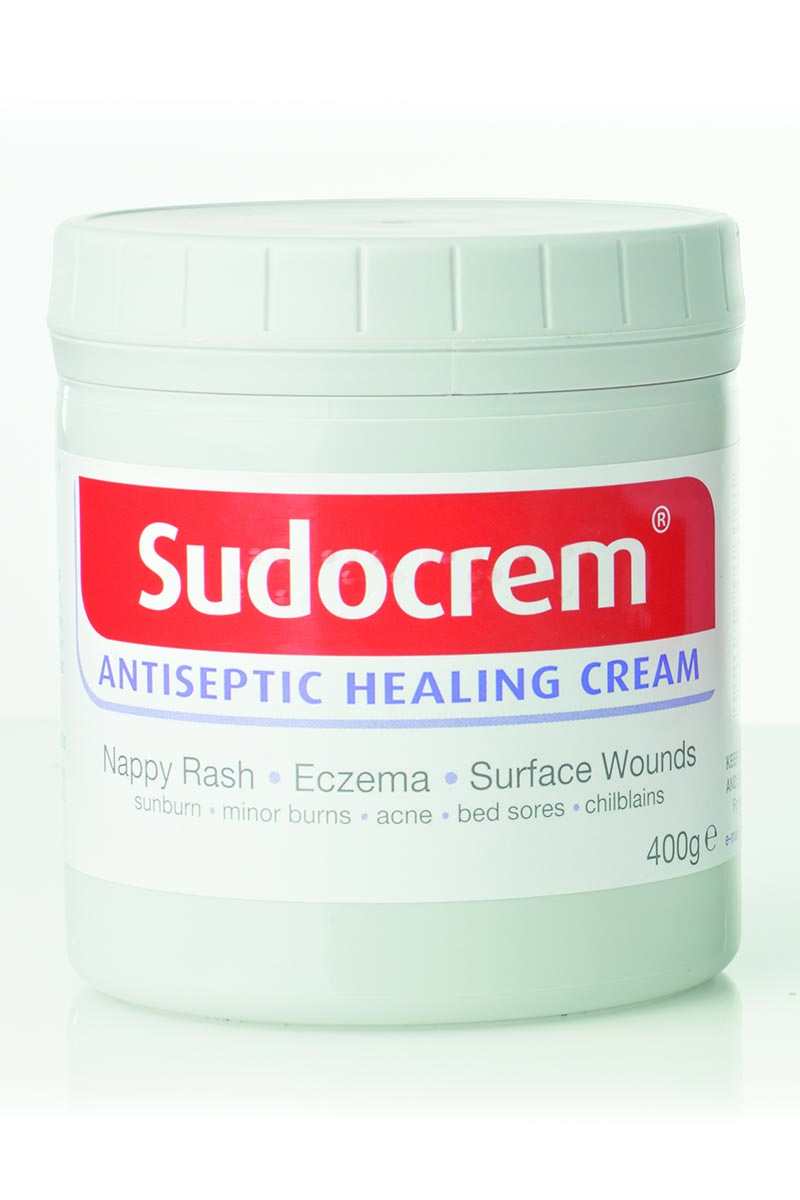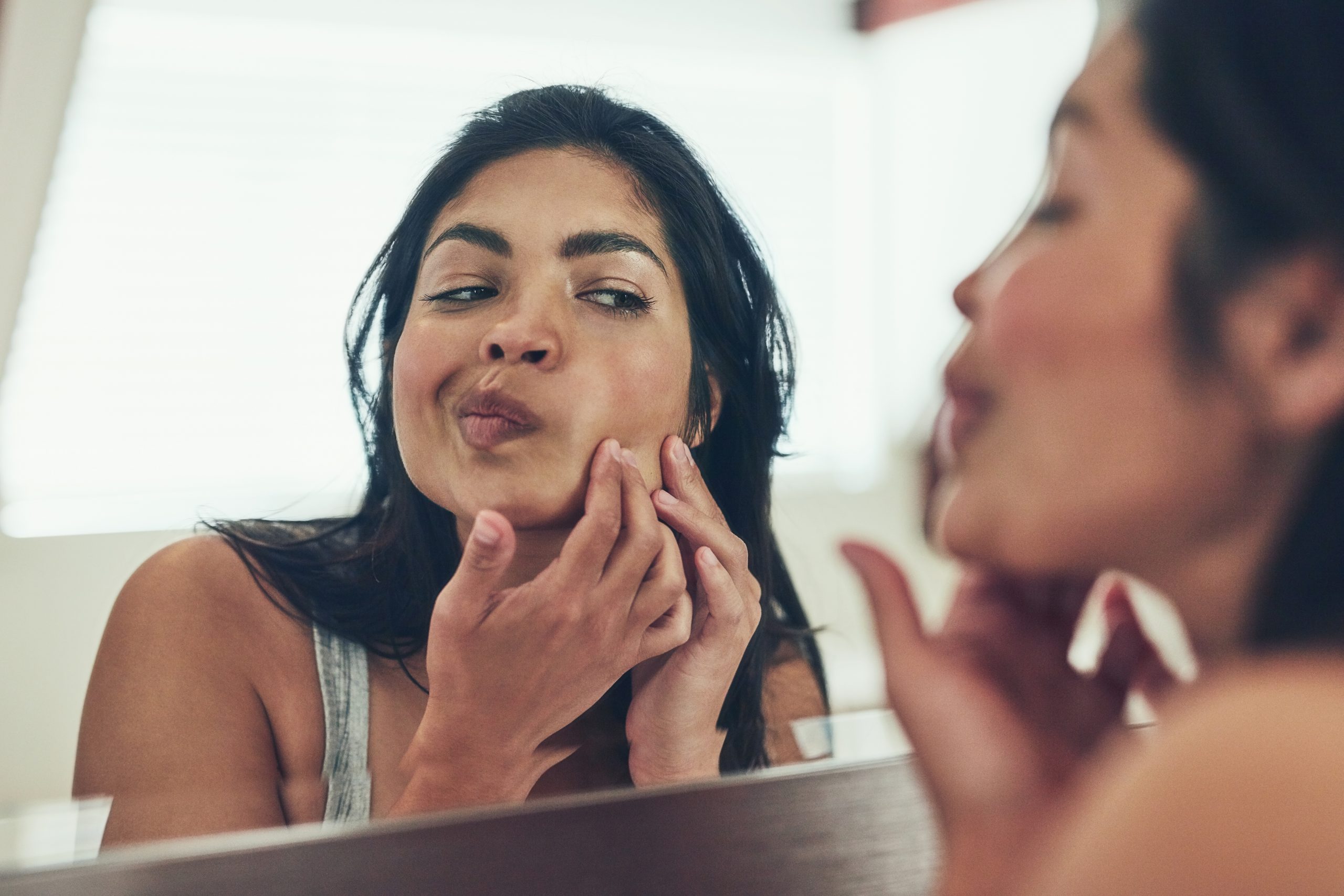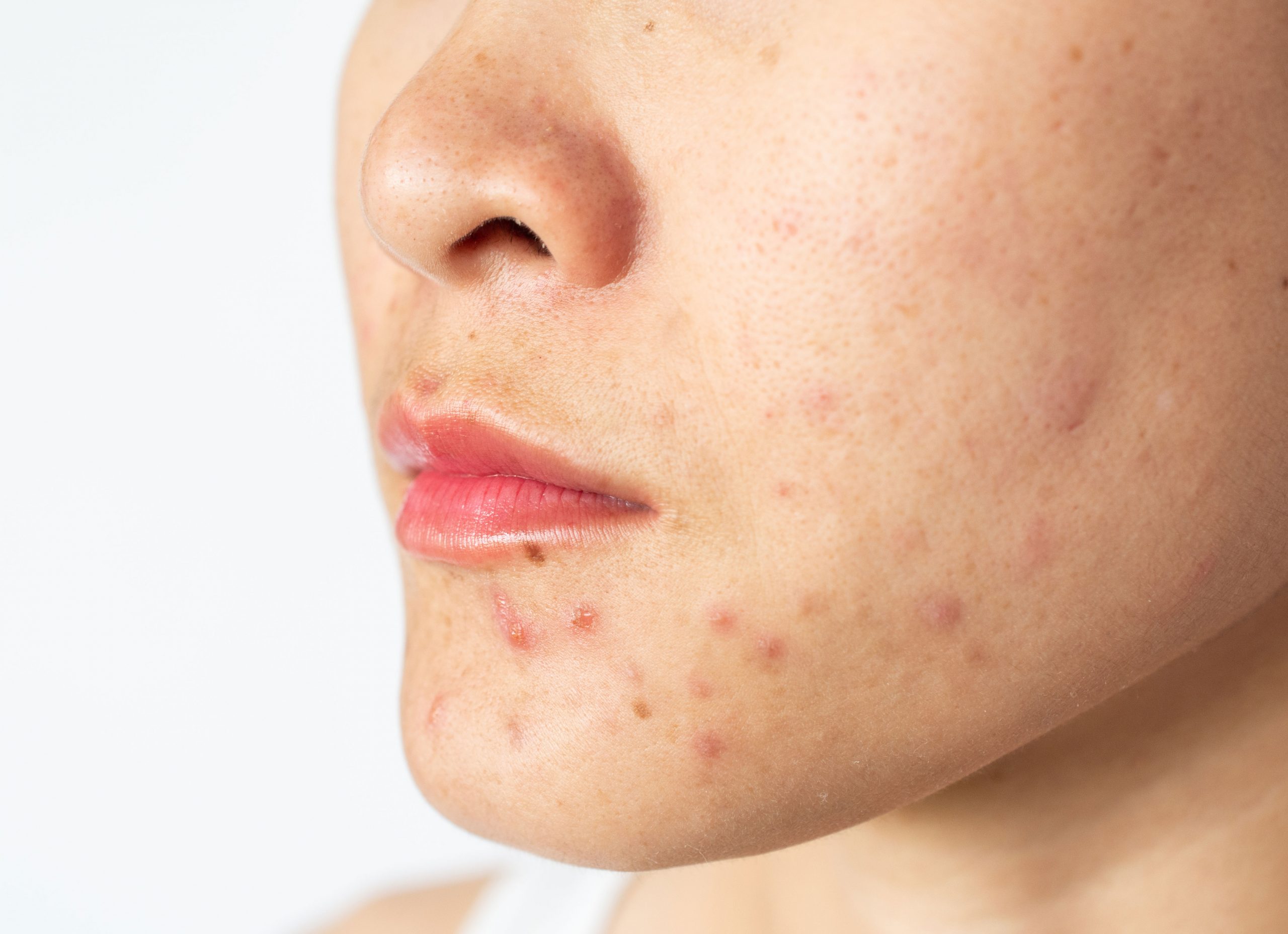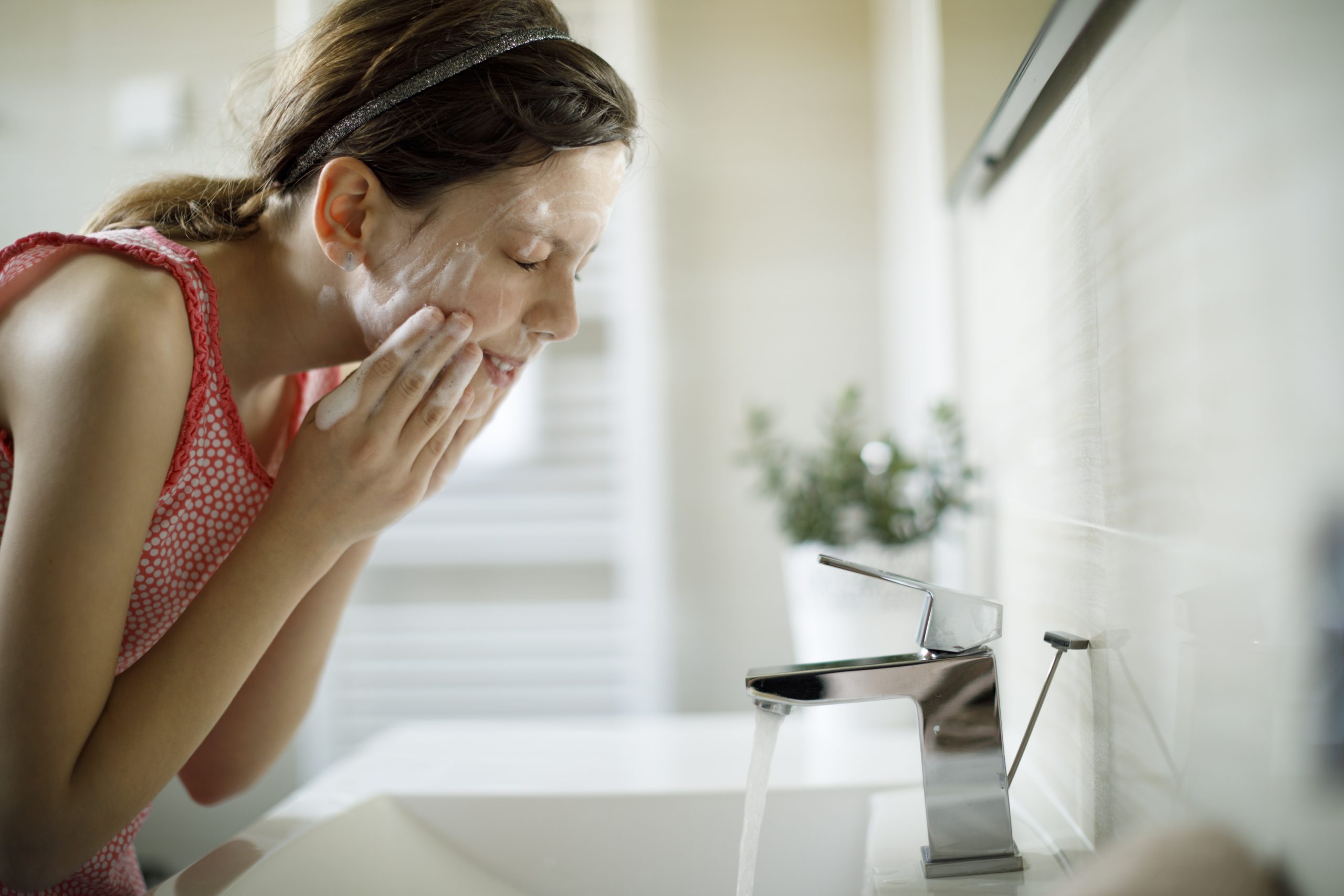What spots on different areas of your face mean
Have you been fighting those troublesome spots correctly? Find out how to banish the pimples on every part of your face.


Almost everyone will suffer from spots at some point. But, what do spots on different areas of you face mean - and how can you get rid of them?
Spots can appear all over the face and body and this can happen for different reasons, with hormones, lifestyle and diet often playing a part in where they pop up. It's vital to think about taking different measures based on where the problem areas of your skin are.
Skin specialist Dr Emma Cunningham explains that spots are a heightened immunological response to the body’s hormone levels resulting in over production of oil, known as sebum. "This increase in sebum changes the activity of a commensal skin bacteria, which becomes aggressive and causes inflammation. The lining of the hair follicles thicken. This results in clogged pores and the end result is a blackhead, whitehead or a spot," she says.
A number of factors can actually exacerbate this process. Fluctuations in hormone levels, which of course women and teenagers are particularly susceptible to, can cause an overproduction of sebum. Not cleansing your skin properly can leave a residue of dirt, oil and debris on your skin that blocks pores. While cleansing too harshly can irritate your skin and worsen any blemishes you might already have.
Spots on forehead
What causes forehead spots? Though a fringe can hide a blemished forehead, it can also cause a build up of sweat and styling products that will increase the likelihood of spots in this area - but there can be more behind forehead spots than just your hairstyle. High amounts of fat in your diet can also lead to breakouts across the forehead.
How to get rid of forehead spots - Try increasing your water intake. you could also try watching your fat levels and eating more blueberries, blackberries and raspberries, which are rich in skin-kind antioxidants.
Spots on cheeks
What causes cheek spots? Spots on the cheeks can be caused by the everyday objects we place on our faces and the bacteria they harbour. Mobile phones and pillowcases are often teeming with acne causing germs that easily transfer onto our faces. Spots on the cheeks can also be linked to the respiratory system, meaning spotty cheeks can be caused by smoking.
GoodtoKnow Newsletter
Parenting advice, hot topics, best buys and family finance tips delivered straight to your inbox.
How to get rid of cheek spots? Wash your pillows and bedding on a regular basis and make sure to wipe your mobile phone down with an antibacterial wipe every day. It’s also a good idea to keep your hands nice and clean if you’re prone to touching your face. Whether you smoke or not, try and take longer and more regular walks in green outdoor spaces. This will increase the amounts of fresh air in your lungs and could help to banish cheek spots.

Spots on chin and jawline
What causes spots on the chin and jawline?Hormone fluctuations triggered by the menstrual cycle can cause spots on the chin, meaning women may notice a pattern of when chin acne makes an appearance. Meanwhile, rich, heavy and high-fat foods can lead to spots on the chin area too, so if you've had an indulgent week, you might find that your chin is more spotty than usual.
How to get rid of spots on the chin and jawline? While resisting indulgent and calorie-laden food can be a struggle, it’s a good idea to cut down and introduce more fibre rich foods like fruit, veg and beans into your diet if you suffer from chin spots. Make sure to up your water intake too, as this can really help clear up a spotty chin. If you notice that a change in hormones around your period triggers an angry outburst of acne then consider chatting to your GP about hormonal contraceptive options that could help keep menstruation spots at bay.
Spots on nose
What causes spots on the nose? The pores on the nose are dilated, so spots here are often caused by a build-up of dirt and make-up products as well as excess sebum production. According to Dr Emma, a spotty nose can also be caused by stress, with high blood pressure linked to nose breakouts.
How to get rid of spots on the nose - Making sure make-up brushes are clean and that you are removing make-up, dirt and grime from your face at the end of every day and cleansing the face in the morning too is a great way to banish spots in general and especially those on the nose. Dr Emma explains that finding ways to reduce stress and cutting down on things that cause high blood pressure (like booze and fatty foods) are good ideas if you’re hoping to get rid of chin spots, too. “Adopting a good sleep routine and engaging in mindfulness and stress busting activities can help regulate/reduce cortisol levels which will help,” she says.
Spots in ears
What causes ear spots? Spots on the ears are often a sign that your body is dehydrated and if you have acne popping up on your ears regularly, it’s definitely time to up your water intake and cut down on food and drinks that cause dehydration. It's also crucial to make sure your ears are clean and free from dirty, grime, make-up traces and oil at the end of the day.
How to get rid of ear spots - Drink plenty of water every single day - or opt for sugar free diluting juice if plain old H2o isn’t your thing. Around two litres a day is a good amount to aim for and will ensure your body and skin isn’t desperate for a drink. Keeping a bottle of water with you at all times will make sure you consume more and setting regular reminders on your phone to give it a chug will help. You should also avoid consuming too many dehydrating substances too - these include coffee, caffeinated tea, alcohol and salt.
Spots in eyebrows
What causes eyebrow spots? Spots on the eyebrows can be caused by a build up of sweat, oil and beauty products in the eyebrow hair - this can clog the hair follicles and result in spots.But they can be caused by stress too - the hormones released from our kidneys when the adrenal glands flare up are linked to painful spots under and around the brows.
How to get rid of eyebrow spots -While reducing stress can play a part - making sure to thoroughly clean your eyebrows when you wash your face during your skincare routine is a must. Removing dead skin cells, oil, dirt and make-up from in amongst the brow hairs is key if you want to prevent eyebrow spots.
Spots in hairline
What causes hairline spots? Spots in the hairline are most often linked to the build up of sweat, oil, dirt and general grubbiness around the area. Products like hairspray, hair gel and dry shampoo can also clog the pores and hair follicles around this area, resulting in spots.
How to get rid of hairline spots - The best cause of action if you’re struggling with hairline spots is to up your hair hygiene and make sure you get up into the hairline when removing make-up and grime from the day. Try cutting back on products like hair spray, waxes, clays and dry shampoo if you use these, as these products could be the spot-causing culprit. You could also try switching your shampoo and conditioner for a gentler option with less fragrance and ingredients like silicones and oils as these can trigger breakouts and irritation too.

Types of spots
There are four main types of spots - blackheads, whiteheads, pustules, and cysts.
Blackheads and whiteheads - These are extremely common and almost everyone will have them at some point in their lives. Dermatologist Dr Beibei Du-Harpur explains that blackheads and whiteheads are both caused by a buildup of sebum and dirt in the pores but react differently depending on how exposed they are. She says, “Blackheads and whiteheads are types of ‘comedones’. “Comedones, sometimes referred to as ‘clogged pores’, occur when there is a build up of dirt and sebum. When the comedones are ‘closed’ they are whiteheads but when the blocked pore is ‘open’ and exposed to air, the contents oxidises and turns black, resulting in a blackhead.”
Cysts - Cystic spots appear as red, hard lumps under the skin that can be painful to touch. They are caused by pus filled bumps that form under the skin as a result of oil build up as well as trapped dirt, bacteria, skin cells and make-up. They appear on the face but also often form on the back, neck, chest and shoulders.
Pustules - Pustules are bumps on the skill that become filled with pus and fluid. They usually appear as white lumps surrounded by inflamed red skin and can grow to be quite large. Pustules can form on any part of the body but mainly appear on the face, back and neck and can often form in clusters. Pustules can appear due to allergic reactions to food or insect bites but are mainly caused like other spots - with a build up of sebum and dirt in the pores.
Should you squeeze spots and blackheads?
Skincare experts recommend you avoid squeezing spots and blackheads - no matter how tempting it may seem. Dr Emma explains that giving a spot a good squeeze can actually make it far worse. “More often than not it can actually result in you pushing the bacteria and pus deeper into the skin, resulting in further inflammation and redness, not to mention the trauma can lead to skin breaking and irritation often leading to scarring.”
The NHS also advises those suffering from acne to avoid "cleaning out" or squeezing blackheads.
If you really can’t resist popping an oozing spot, then use a tissue over your fingers, make sure your hands are clean and apply gentle pressure. DO NOT keep squeezing once the pus is out or if the pus doesn't come out easily. If you see blood or bruising, stop! You may end up scarring your skin.
Does toothpaste get rid of spots?
If you suffer from spots it’s likely you’ll have attempted the years-old trick of using toothpaste to get rid of them. But does it actually work? Dr Emma says no. Avoid this common beauty myth at all costs.
While it may dry out spots initially, it can actually make them worse and cause them to become red and irritated.
"Contrary to popular belief the use of toothpaste in the treatment of pimples probably does more harm than good," says Dr Emma. "It is true that there are several ingredients in toothpaste like triclosan and baking soda that may help ‘dry’ out the pimple but the concentrations they appear at although not harmful to teeth, is likely to cause more irritation to the surrounding skin exacerbating the situation."

How often should you wash your face?
There's a fine line between washing your face too much and washing too infrequently and it is important to adopt a good cleansing regime for both morning and night.
Dr Emma says, "Double cleansing in the evening will ensure complete removal of dirt/make up and pollutants. I recommend cleansing with a gentle cleanser to help aid with removal of dead skin cells, therefore helping with clogged pores and reducing breakouts."
As for the morning, you might think your face is still clean from the evening wash - but it’s not.
Overnight, your skin can collect dirt and debris from your pillowcase, and any pollutants in the air. Plus, a morning wash can wake you up, freshen up your face and leave it clean and prepped for a daily skincare routine.
How to wash your face properly
Facial aesthetics expert Dr Jaskaren Midha explains that it’s important to take steps to prevent skin damage when you wash your face, revealing that we should wash the face with cool or warm water - not hot.
"This is to ensure you don’t strip the skin of the natural oil your body produces. Using hot water may irritate the skin and cause it to become dry.
"Using a light, clean washcloth that is gentle on your skin or even just your hands work the cleanser into your skin. Take your time to ensure all traces or make-up and dirt are removed. Pat dry with a towel, don’t rub or use force this can again irritate the skin. Finish by applying moisturiser."
"It is important to cleanse your skin without being overly harsh or scrubbing excessively, and moisturise to prevent excessive dryness and irritation which can trigger breakouts in themselves," adds Dr Beibei Du-Harpur.
It's always a good idea to wash your face after a workout, though. Sweat and bacteria can build up on the face, clogging pores. If you wait a while between exercise and showering, you might find your back gets spottier. It's wise to take off your sports kit as soon as possible and get showering!
Which products can help get rid of spots?
There are various skincare ingredients loved by dermatologists and beauty fans that are great for treating spots.
Dr Beibei recommends using products containing the likes of salicylic acid, benzoyl peroxide and retinol to help reduce spots, meanwhile acids like glycolic acid and niacinamide can be great for exfoliating and reducing oiliness.
Go gradual when it comes to introducing acids into your routine if your skin is sensitive and don't combine them all at once!
Toning with a glycolic acid toner after cleansing and using a niacinamide serum followed by a good sunscreen and moisturiser is a good place to start in the morning.
At night use either a retinol, salicylic acid or benzoyl peroxide product followed by your moisturiser to help calm your spots as you sleep. Don't combine these ingredients though - this could cause irritation.
Many spot sufferers also swear by using Sudocrem to help sooth and lessen redness on angry spots.

Caitlin is a Junior News Editor for Goodto.com, covering all things royal, celeb, lifestyle, food, and family. Having set her sights on becoming a magazine journalist when she was a child, Caitlin took on work experience stints at local papers and titles such as Cosmopolitan, Now, Reveal and Take a Break while studying for her Multimedia Journalism degree and has interviews with celebs, reality stars and the Archbishop of Canterbury under her belt (of course, she couldn't resist asking him about Meghan Markle and Prince Harry).